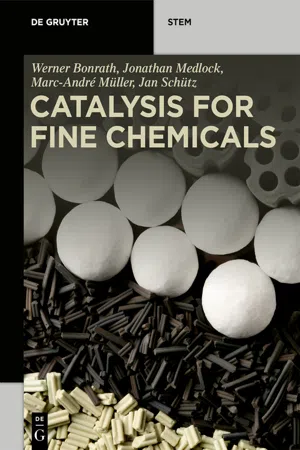
eBook - ePub
Catalysis for Fine Chemicals
This is a test
- 403 pages
- English
- ePUB (mobile friendly)
- Available on iOS & Android
eBook - ePub
Catalysis for Fine Chemicals
Book details
Book preview
Table of contents
Citations
About This Book
A wide range of chemical products (especially fine chemicals) are important for a healthy and enjoyable modern life; therefore efficient syntheses of these materials are essential. Traditional stoichiometric processes need to be replaced by modern catalytical methods in the change to sustainable chemistry and the production of lower amounts of waste.
This book summarizes the wide variety of catalytic methods that have been developed and applied on an industrial scale in recent years to fulfill this goal. The synthesis of compound classes such as pharmaceuticals, agrochemicals, flavoring, and fragrance compounds as well as food additives such as vitamins exemplify the use of these modern catalytic methods in the modern chemical industry.
Frequently asked questions
At the moment all of our mobile-responsive ePub books are available to download via the app. Most of our PDFs are also available to download and we're working on making the final remaining ones downloadable now. Learn more here.
Both plans give you full access to the library and all of Perlego’s features. The only differences are the price and subscription period: With the annual plan you’ll save around 30% compared to 12 months on the monthly plan.
We are an online textbook subscription service, where you can get access to an entire online library for less than the price of a single book per month. With over 1 million books across 1000+ topics, we’ve got you covered! Learn more here.
Look out for the read-aloud symbol on your next book to see if you can listen to it. The read-aloud tool reads text aloud for you, highlighting the text as it is being read. You can pause it, speed it up and slow it down. Learn more here.
Yes, you can access Catalysis for Fine Chemicals by Werner Bonrath, Jonathan Medlock, Marc-André Müller, Jan Schütz in PDF and/or ePUB format, as well as other popular books in Physical Sciences & Industrial & Technical Chemistry. We have over one million books available in our catalogue for you to explore.
Information
1 Introduction and fundamental aspects
Today, the application of catalysts is fundamental for efficient synthetic methods and production processes. During the last decades in the fine chemicals industry, and partly in the pharmaceutical industry, many chemical conversions which require stoichiometric amounts of reagents have been replaced by catalytic processes. In the bulk chemical industry, the application of catalytic methods is already well established. This difference can be partly explained by the higher complexity of pharmaceuticals and fine chemicals which makes catalysis more demanding and process development more expensive and complex.
In this chapter, we review some of the general concepts, techniques and principles that are important for the discussion of the examples in the later chapters. It is not supposed to be a comprehensive introduction to these topics, rather a refresher/reminder of important points to remember. For more detailed information and discussion of the points in this chapter, please refer to a standard textbook on catalysis, for example, [1, 2, 3, 4, 5, 6].
The definition of the term catalyst is based on the fundamental work of Wilhelm Ostwald (Nobel Prize, 1909).
“A catalyst is a compound which influences the reaction rate of a chemical reaction without being consumed and without the ability to influence the thermodynamic equilibrium of the catalysed reaction [7, 8, 9, 10, 11, 12].”
Catalysts influence reactions that are thermodynamically possible (see also Hess’ law); the function of a catalyst is to decrease the activation energy (EA) of the reaction by providing an alternative pathway or mechanism for the reaction to follow (Figure 1.1).

Figure 1.1: Energy–reaction coordinate of catalysed and non-catalysed reactions.
Wilhelm Ostwald had a tremendous influence on the field of physical chemistry and catalytic concepts. His work was world-leading for decades and resulted in various industrial applications. For instance, the Ostwald process for nitric acid later became the basis of the work of Haber, Bosch and Mittasch for the ammonia process from hydrogen and nitrogen. Nowadays, catalysts have significant impact on industrial production processes. It is assumed that 90% of all chemically obtained industrial goods come in contact with at least one catalytical production step during their manufacture [13].
The main targets of catalytic reactions are:
- Mild reaction conditions,
- Decreased waste formation,
- Increased selectivity,
- Increased efficiency.
From a physical chemistry point of view, catalytic reactions can be divided into homogeneous and heterogeneous reactions. In heterogeneous catalysis, the catalyst and the substrate are in separate phases, for example liquid/solid, solid/gas. In homogeneous catalysis, the catalyst and substrate are in one phase. The general advantages and disadvantages of homo- and heterogeneous catalysed reactions are summarised in Table 1.1. In particular, because of their easy separation and recovery, heterogeneous catalysts are more frequently found with increasing product volumes and decreasing product prices. In contrast, for asymmetric reactions, homogeneous catalysts are clearly superior to heterogeneous systems.
Table 1.1:Advantages and disadvantages of heterogeneous and homogeneous catalysed reactions....
Table of contents
- Title Page
- Copyright
- Contents
- Preface
- 1 Introduction and fundamental aspects
- 2 Heterogeneous hydrogenations
- 3 Homogeneous hydrogenations
- 4 Oxidations
- 5 Gas-phase reactions
- 6 C–C-bond and C–N-bond forming reactions (metal-catalysed)
- 7 Rearrangement reactions
- 8 Acid–base-catalysed reactions
- 9 Phase transfer catalysis (PTC)
- 10 Biocatalysis
- 11 New trends
- Index